Mike Vardy's Blog, page 52
April 4, 2018
Reading People with Anne Bogel
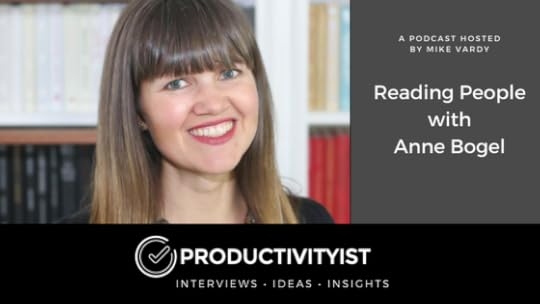
Today’s guest is Anne Bogel. Anne is a podcaster, blogger, and author. She is also known as a tastemaker through her popular book lists and reading guides. Recently, Anne wrote a new book titled Reading People: How Seeing The World Through The Lens of Personality Changes Everything. We spoke about the power of reading, personality frameworks, and why it is important to be self-aware.
Here are some highlights of the show:
The different kinds of personality tests: Enneagram, Myers Briggs, DISC
Why the same activity can be healthy for some people but stressful for others
Knowing your motives so you can be really productive
Why many introverts can look like extroverts
Why circumstances can affect how introverted or extroverted we are in different situations
The importance of taking time to step back and reflect
Relevant Links:
Anne Bogel’s website
Reading People: How Seeing the World Through Lens of Personality Changes Everything | Amazon
The Power of Moments | Amazon
The Road Back to You: An Enneagram Journey to Self-Discovery | Amazon
Quiet: The Power of Introverts in a World That Can’t Stop Talking
Enneagram Test
Myers Briggs Test
Thanks for listening. If you enjoyed the show don’t forget to subscribe so you don’t miss a single episode. Until next time remember to stop guessing…and start going!
If you’re interested in supporting the podcast and receiving exclusive content while doing so, you’ll want to check out the patrons-only version of The Productivityist Podcast on Patreon. Also, remember to leave The Productivityist Podcast a rating and review on iTunes, or on whatever platform you’re listening to. I read every single bit of feedback we receive. I want to make this show better and with your help I can do that. If you’d just like to support the podcast on its own, you can do so here.
The post Reading People with Anne Bogel appeared first on Productivityist.
March 28, 2018
Possess Your Success with Andrew McDonald
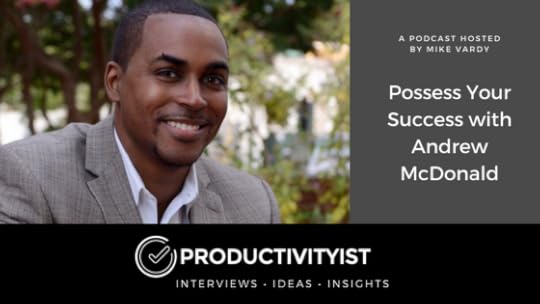
This episode of The Productivityist Podcast is sponsored by Health IQ, an insurance company that helps health conscious people like runners, cyclist, weightlifters and vegetarians get lower rates on their life insurance. Go to healthiq.com/vardy to support the show and see if you qualify.
It’s time for another episode of the Productivityist Podcast! Our guest this week is Andrew McDonald. Andrew is a self-made speaker, author, and coach whose passion is to leave the world better than he found it. Tune in as we spoke about imposter syndrome, navigating through negative situations, getting unstuck, and the power of a morning routine.
Here are some of the highlights of the show:
One simple thing you can do to get unstuck
The power of journaling
Things that hamper your productivity
Boundaries and opportunities cost
Making reminders through rules to avoid information overload
Using feedback to reflect, learn and grow
Handling big life changes
Relevant Links:
Possess Your Success
Stop Worrying About What Other People Think
New Opportunity – 3 Considerations Before Saying Yes or No
Set Reminders to Elevate Your Productivity
Self-Reflection: 7 Questions to Ask Yourself to Keep Moving Forward
Thanks for listening. If you enjoyed the show don’t forget to subscribe so you don’t miss a single episode. Until next time remember to stop guessing…and start going!
If you’re interested in supporting the podcast and receiving exclusive content while doing so, you’ll want to check out the patrons-only version of The Productivityist Podcast on Patreon. Also, remember to leave The Productivityist Podcast a rating and review on iTunes, or on whatever platform you’re listening to. I read every single bit of feedback we receive. I want to make this show better and with your help I can do that. If you’d just like to support the podcast on its own, you can do so here.
The post Possess Your Success with Andrew McDonald appeared first on Productivityist.
March 26, 2018
How To Be As Productive As Possible When You’re Sick
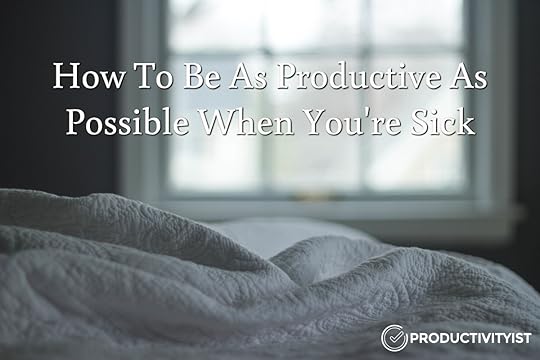
It all starts with a sniffle or a cough. You ignore the warning signs and power through anyway. Finally, your body starts to rebel, and your head feels like it is in the clouds. Let’s face it: you’re sick. You need rest. We’ve all been there. What can you do to be as productive as possible?
Admit You’re Sick
Once you admit you’re not feeling well, you can manage your expectations. This is quite possibly the most important step toward being productive. Why? You may need to take some time off to rest and heal. Being as self-aware is a foundational element of your personal productivity, so just be honest with yourself. Working too hard when you’re under the weather can do more harm than good. You can actually shorten your illness by getting the rest you need.
Allow Others To Step In
I know it is common to try to do it all on your own, but in most cases, the best move is to ask for some help from your co-workers, team members or family members. Ask for a deadline extension or to reschedule a meeting. You may even want to set up your email autoresponder to let people know they won’t receive a response for a few days. In most situations, you’ll receive grace and empathy.
Build Yourself A Buffer
You can give yourself some breathing room by working ahead whenever possible. (Working by mode is very helpful for this, but I’ll talk about that more in a second.) Let’s face it: no one plans on being sick. And if you have kids, as you know, when one child gets sick, soon the rest of the family gets sick, right? By working ahead you can give yourself some breathing room in your calendar and stay more productive over the long-term.
Be Okay With Taking Some Time Off
We all have a tendency to want to do more and be more productive. It’s not a race; we are not in competition with one another. Remember, productivity is personal. Rest is an important part of life; in order to perform at high levels, rest is a requirement.
TimeCrafting Can Help
Let’s assume that you got sick on Meeting Day or Admin Day. TimeCrafting offers you the flexibility so you could simply change out one day for the other. You may even be able to simply reschedule tasks you missed on Monday to next Monday. If your schedule does not allow this, you can always try doing a Weekly Sprint when you return to work; you could schedule meetings or admin work for a specific one-hour (or another fixed amount of time) slot each day. The great thing about Weekly Sprints are that they give you a sense of rhythm by working on the same task at the same time.
Mike also uses what he calls Braindead Mode for when he knows he is really tired or not feeling very alert. This mode includes simple tasks like social media sharing, scanning receipts and doing household chores. So, if you feel a surge of energy, maybe you could do a load of laundry or work on some meal planning. If you’d like more information about TimeCrafting works, check out the one-page cheat sheet below.
The post How To Be As Productive As Possible When You’re Sick appeared first on Productivityist.
March 21, 2018
Declutter Your Way to Success with Terri Savelle Foy
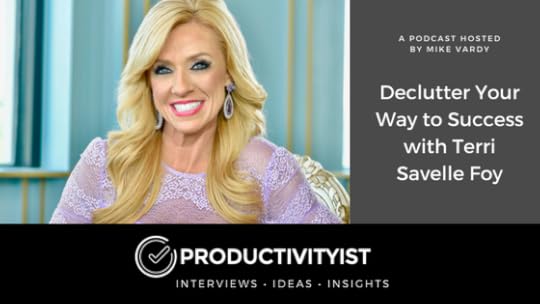
This episode of The Productivityist Podcast is sponsored by Health IQ, an insurance company that helps health conscious people like runners, cyclist, weightlifters and vegetarians get lower rates on their life insurance. Go to healthiq.com/vardy to support the show and see if you qualify.
Today’s guest is Terri Savelle Foy. Terri is a motivational speaker, Youtuber and cheerleader of dreams. Terri is also the author of a new book called Declutter Your Way to Success: the Keys to Organize Your Life. We spoke about how your environment affects your mindset, why it is important to define your definition of organization and how you can maintain a standard of excellence in your life.
Here are some highlights of the show:
Our homes reflect our inner state
Why unfinished tasks can stall deep work
The “laundry basket of success”
Why changing the world starts with making your bed
Building a momentum by using a timer
Using the “Don’t Break the Chain” method with a calendar
Relevant Links:
Terri Savelle Foy
Declutter Your Way to Success | Amazon
Declutter Your Way to Success Kit
Make Your Bed First
Terri Savelle Foy | Twitter
Thanks for listening. If you enjoyed the show don’t forget to subscribe so you don’t miss a single episode. Until next time remember to stop guessing…and start going!
If you’re interested in supporting the podcast and receiving exclusive content while doing so, you’ll want to check out the patrons-only version of The Productivityist Podcast on Patreon. Also, remember to leave The Productivityist Podcast a rating and review on iTunes, or on whatever platform you’re listening to. I read every single bit of feedback we receive. I want to make this show better and with your help I can do that. If you’d just like to support the podcast on its own, you can do so here.
The post Declutter Your Way to Success with Terri Savelle Foy appeared first on Productivityist.
March 14, 2018
More Fun in Done with Marli Williams
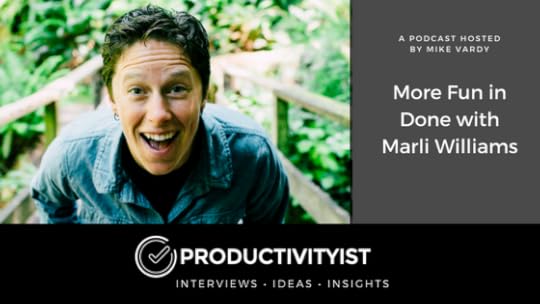
This episode of The Productivityist Podcast is sponsored by Health IQ, an insurance company that helps health conscious people like runners, cyclist, weightlifters and vegetarians get lower rates on their life insurance. Go to healthiq.com/vardy to support the show and see if you qualify.
Today’s guest is Marli Williams. Marli is a speaker, activation coach, purpose finder and inspiration generator. Her mission in life is to inspire and empower people to go from stuck to STOKED! In this episode, we spoke about the power of live, in-person events, courage, growth and living a life of fun.
Here are some highlights of the show:
What made her decide to quit a day job she enjoyed
The power of quotes in providing inspiration
The value of in-person experiences in a comfortable setting
We are more connected than ever before but still long for meaningful connections
Doing things whenever you want during the year
Making tasks more fun and enjoyable
Enjoying the process of creation as well as the goal
Asking questions like “How can I make this more fun?”
Knowing your strengths and getting help in other areas
Relevant Links:
Marli Williams Website
Marli Williams @marli_williams | Twitter
Thanks for listening. If you enjoyed the show don’t forget to subscribe so you don’t miss a single episode. Until next time remember to stop guessing…and start going!
If you’re interested in supporting the podcast and receiving exclusive content while doing so, you’ll want to check out the patrons-only version of The Productivityist Podcast on Patreon. Also, remember to leave The Productivityist Podcast a rating and review on iTunes, or on whatever platform you’re listening to. I read every single bit of feedback we receive. I want to make this show better and with your help I can do that. If you’d just like to support the podcast on its own, you can do so here.
The post More Fun in Done with Marli Williams appeared first on Productivityist.
March 12, 2018
How To Transform A Single Daily Theme Into An Everyday Focus
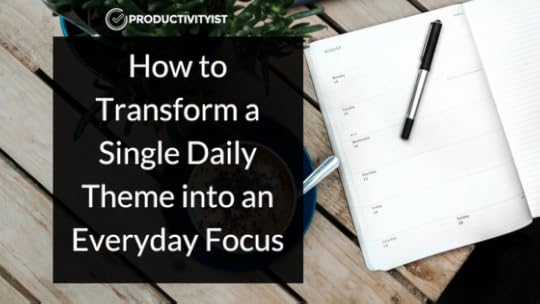 Administrative tasks are the bane of my existence.
Administrative tasks are the bane of my existence.
I classify administrative tasks as those that require more of “maintenance mindset” than anything else. While these tasks don’t move me forward in leaps or bounds, not doing them can hinder progress on other tasks that lead to greater gains.
Ever since I started theming my days I’ve set aside one day of the week to focus on administrative tasks. I figured that by dedicating a day to them I could get into a state of flow and be more productive. My goal was to deal with these tasks and get them out of the way so I could focus on other work like writing, recording audio content, diving into deep work, learning new skills, and so on.
However, when I returned from two conferences in San Diego – Traffic and Conversion and Social Media Marketing World – I found myself reevaluating the concept of giving a whole day to these types of tasks.
A Change Was Needed
Both of these conferences focused on marketing in some way, shape, or form. There were definitely some crossover takeaways from them, most notably the following:
1. Video content and marketing is more important than ever
2. Chatbots and Live message automation is worth exploring
3. Don’t put all your eggs in the Facebook advertising basket
The first takeaway started an internal dialogue around my Daily Themes. One of my days had been focused on administrative work. Another day was dedicated to doing audio and video work. Since video is something I want to invest more time, energy, and attention on, it can no longer share a day with audio work.
My first decision was to make Wednesday’s theme one that placed a focus on any and all audio work. Once I made that call, I immediately leveraged the newly-found space by creating a daily podcast called Three Minutes of TimeCrafting. I’ve been able to dive even deeper into existing audio tasks that have been shelved for a while.
Next, I had to find a home for a new Daily Theme: Video.
Finding a Day for a Fresh Daily Theme
Here was what my Daily Themes looked like before making the shift:
Sunday: Planning
Monday: Optimization
Tuesday: Administrative
Wednesday: Audio/Video
Thursday: Training
Friday: Deep Work
Saturday: Family
It was pretty safe to keep Wednesday as my Audio Day because all of my upcoming podcast interviews were scheduled in advance for weeks to come. I didn’t want to choose Sunday, Monday, Friday, or Saturday for video work because it would be possible or likely that members of my family would be home on those days. That left Tuesday and Thursday as the remaining options. I’ve reserved Thursday for training – meaning training others and myself in new skills – for as long as I can remember, and I have some standing coaching appointments on Thursday as well. I felt as if altering it to put video in its place would be no different than me trying to do the same on Wednesdays. It just didn’t make sense. It would cause friction in more ways than it wouldn’t.
So I decided that Tuesday was going to be my new Video Day.
Choosing Tuesdays really makes the most sense. It had all the qualities I was looking for when it came to working video content.
1. Tuesday is a quiet day. My wife Anne would be around for part of the day, but the kids would never be home unless it was an extended holiday break or they were ill. I could get at least 4 hours of footage filmed without distraction or disruption.
2. Tuesday is early in the week. I can film on Tuesdays and begin post-production to have a weekly video posted on YouTube by Friday. I am able to do Facebook Live shows on that day and can incorporate them into the weekly digest email I send out every Thursday known as The Dailies.
3. I want to optimize how I handle administrative tasks. Giving them a single day wasn’t working any longer. It wasn’t reasonable for me to only handle those types of tasks once per week. I also found that Tuesdays are my least productive days. When using my ZEI° (made by the folks at Timeular), I found that most of my short entries were on Tuesdays while my longer entries were on Wednesdays, Thursdays, and Fridays. I think that has a direct correlation to how often I was switching tasks and task modalities on my now-defunct Administrative Day.
Finding Days for a Former Daily Theme
Even though administrative tasks are the bane of my existence, I recognize they need to be dealt with regularly. Since I determined that having them fall under a single Daily Theme wasn’t working, I needed to come with a way to make sure they still had my attention throughout the week. So I decided to take stock of other types of tasks that needed to be done consistently as well so I could try to craft them as Horizontal Themes going forward.
In order to properly do this, I decided to look at The 5 Categories of Mode-Based Worksheet that I’ve created. If you’re unfamiliar with these categories, they are:
Theme-Based Modes
Resource-Based Modes
Energy-Based Modes
Activity-Based Modes
Time-Based Modes
I explain what falls into each category in a downloadable PDF, which you can get by entering your email address below. (I’ll also send you some occasional emails that will help you adopt TimeCrafting as well when you sign up.)
I recognized that the last category, Time-Based Modes, wouldn’t work in this strategy because it is best used either within existing Horizontal Themes or Daily Themes. A Resource-Based Mode wouldn’t work either because it is too narrow in scope. So I was left with Theme-Based Modes, Energy-Based Modes, and Activity-Based Modes.
At this point I reviewed Todoist to see what types of tasks were labeled with the Administrative label. I suspected many of them would be tasks that were easy to do and require less depth of focus than any of the other tasks I had in the app.
I was right.
In fact, one of my coaching clients and I had discussed the idea of “maintenance” as a label for tasks that were essential to keep things going but didn’t involve deep focus or even great effort. They were, by definition, tasks you needed to do to simply maintain things.
With that, I created a Horizontal Theme called Maintenance (which I changed to Maintaining after choosing the next two themes. You’ll know why once I reveal them to you.)
Each morning I allocated the 9-10am time slot to tasks that fall into the Maintaining theme. Why? My energy level is lower in the morning due to me being a night owl – or “wolf” as suggested by Dr. Michael Breus in his book The Power of When. Ideally, I should be doing lower energy tasks before lunch, and I used Dr. Breus’s ideal day for my chronotype to guide me with that decision.
That time slot is set aside for maintenance tasks every day of the week so I wind up with at least 7 hours of that type of work scheduled. That horizontal theme replaces the full day of administrative tasks that I once had assigned to Tuesdays and because I’ve given myself a tighter timeline to finish them in (one hour per day as opposed to all of one day), less time will be wasted overall.
I also noticed that I wasn’t spending as much time writing in the later hours of the day any longer. I’m still very much a night owl, but I find that much of what I do late at night is mapping things out and reflecting as opposed to writing or creating anything. That’s when I decided to create a horizontal theme for writing earlier in the day throughout the week. I wanted a time slot where I could focus on creating things and based on my chronotype the best time of day for me to focus on deeper work was from 2-4pm. So that two hour block of time is now called Making Mode time.
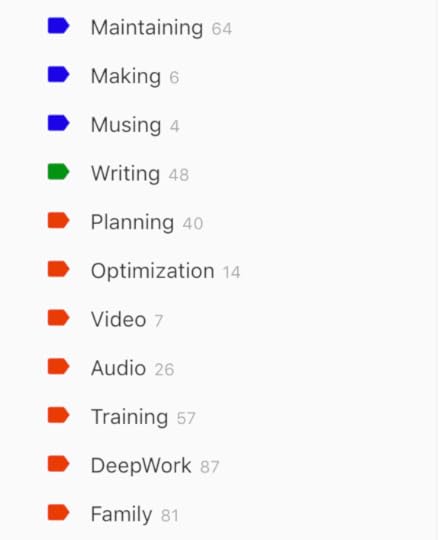
Each day of the week I’ll focus on making stuff during those hours. This includes all types of writing or anything else that requires me making something. I’ve gone as far as to ensure that no one can schedule anything with me during those hours by adjusting my schedule to open up more hours later in the day on Mondays and Thursdays.
As for the old horizontal theme where I did focus on writing – scheduled from 10pm-1am everyday – that is when I go into Musing Mode. I’ve adjusted that time period from 10pm-12am, and during that time I’ll focus on planning, brainstorming, journaling, meditating, and finishing up my evening routine for the day. I’ve found that I’m better suited to do that sort of thing during those hours rather than write, so allocating that time for “musing” activities makes the most sense going forward.
As you can see, I ultimately used elements of all three remaining categories of mode-based work when setting up these three new Horizontal Themes.
Theme-Based Modes: Whenever I make something, it’s a form of deep work. Planning is a form of deep work but has elements of musing in it as well. Maintaining (by my definition) involves many of my administrative tasks. All three of those (administrative, deep work, and planning) either were or still are my Daily Themes.
Energy-Based Modes: I used my chronotype to help decide where my Horizontal Themes should be placed. My energy levels throughout the day played a role in that. I’m better at lower energy tasks in the morning, meaning that doing any kind of maintaining would be ideal earlier in the day. The later hours of the day are better for deeper creative work and reflection so I chose time slots that would work best for me for making and musing based on that understanding.
Activity-Based Modes: The simplest definition of this type of mode is anything ending in “ing” and all of my new Horizontal Themes fit that definition. In fact, I intentionally changed “maintenance” to “maintaining” to match up with the other two new themes to drive that point home.
These new Horizontal Themes override the Daily Themes, so no matter what the Daily Theme is, I’m going to be in Maintaining Mode from 9am to 10am every morning. When you have Horizontal Themes, you can feel less restricted about when you can do certain types of tasks. I know that some people can’t do administrative work only one day of the week; I couldn’t keep that up either.
Rather than tossing out all of my Daily Themes because one wouldn’t work, I added a horizontal theme to the mix to accomplish what I needed. This Horizontal Theme gives me time spread out over the course of the week for certain types of tasks.
So, how did I transform a Daily Theme into an everyday focus?
I now focus on Video on Tuesday (single Daily Theme) but can also make videos between 2 and 4 pm (everyday focus). I may not have a day dedicated to administrative work any longer (single Daily Theme), but I do have one per day that I’ve chosen to work on those sort of tasks (everyday focus). The same goes for Deep Work (deep work = making) and Planning (planning = musing).
Daily Themes on their own won’t work for everyone because you need to work on certain types of tasks throughout the week. Horizontal Themes on their own won’t work for everyone because having an emphasis or focus for each day lowers decision fatigue and keeps you moving things forward. But using both types of themes in tandem can enable you to deal with you need to do and ultimately do more of what you want to do every single day.
The post How To Transform A Single Daily Theme Into An Everyday Focus appeared first on Productivityist.
How to Transform a Single Daily Theme into an Everyday Focus
 Administrative tasks are the bane of my existence.
Administrative tasks are the bane of my existence.
I classify administrative tasks as those that require more of “maintenance mindset” than anything else. While these tasks don’t move me forward in leaps or bounds, not doing them can hinder progress on other tasks that lead to greater gains.
Ever since I started theming my days I’ve set aside one day of the week to focus on administrative tasks. I figured that by dedicating a day to them I could get into a state of flow and be more productive. My goal was to deal with these tasks and get them out of the way so I could focus on other work like writing, recording audio content, diving into deep work, learning new skills, and so on.
However, when I returned from two conferences in San Diego – Traffic and Conversion and Social Media Marketing World – I found myself reevaluating the concept of giving a whole day to these types of tasks.
A Change Was Needed
Both of these conferences focused on marketing in some way, shape, or form. There were definitely some crossover takeaways from them, most notably the following:
1. Video content and marketing is more important than ever
2. Chatbots and Live message automation is worth exploring
3. Don’t put all your eggs in the Facebook advertising basket
The first takeaway started an internal dialogue around my Daily Themes. One of my days had been focused on administrative work. Another day was dedicated to doing audio and video work. Since video is something I want to invest more time, energy, and attention on, it can no longer share a day with audio work.
My first decision was to make Wednesday’s theme one that placed a focus on any and all audio work. Once I made that call, I immediately leveraged the newly-found space by creating a daily podcast called Three Minutes of TimeCrafting. I’ve been able to dive even deeper into existing audio tasks that have been shelved for a while.
Next, I had to find a home for a new Daily Theme: Video.
Finding a Day for a Fresh Daily Theme
Here was what my Daily Themes looked like before making the shift:
Sunday: Planning
Monday: Optimization
Tuesday: Administrative
Wednesday: Audio/Video
Thursday: Training
Friday: Deep Work
Saturday: Family
It was pretty safe to keep Wednesday as my Audio Day because all of my upcoming podcast interviews were scheduled in advance for weeks to come. I didn’t want to choose Sunday, Monday, Friday, or Saturday for video work because it would be possible or likely that members of my family would be home on those days. That left Tuesday and Thursday as the remaining options. I’ve reserved Thursday for training – meaning training others and myself in new skills – for as long as I can remember, and I have some standing coaching appointments on Thursday as well. I felt as if altering it to put video in its place would be no different than me trying to do the same on Wednesdays. It just didn’t make sense. It would cause friction in more ways than it wouldn’t.
So I decided that Tuesday was going to be my new Video Day.
Choosing Tuesdays really makes the most sense. It had all the qualities I was looking for when it came to working video content.
1. Tuesday is a quiet day. My wife Anne would be around for part of the day, but the kids would never be home unless it was an extended holiday break or they were ill. I could get at least 4 hours of footage filmed without distraction or disruption.
2. Tuesday is early in the week. I can film on Tuesdays and begin post-production to have a weekly video posted on YouTube by Friday. I am able to do Facebook Live shows on that day and can incorporate them into the weekly digest email I send out every Thursday known as The Dailies.
3. I want to optimize how I handle administrative tasks. Giving them a single day wasn’t working any longer. It wasn’t reasonable for me to only handle those types of tasks once per week. I also found that Tuesdays are my least productive days. When using my ZEI° (made by the folks at Timeular), I found that most of my short entries were on Tuesdays while my longer entries were on Wednesdays, Thursdays, and Fridays. I think that has a direct correlation to how often I was switching tasks and task modalities on my now-defunct Administrative Day.
Finding Days for a Former Daily Theme
Even though administrative tasks are the bane of my existence, I recognize they need to be dealt with regularly. Since I determined that having them fall under a single Daily Theme wasn’t working, I needed to come with a way to make sure they still had my attention throughout the week. So I decided to take stock of other types of tasks that needed to be done consistently as well so I could try to craft them as Horizontal Themes going forward.
In order to properly do this, I decided to look at The 5 Categories of Mode-Based Worksheet that I’ve created. If you’re unfamiliar with these categories, they are:
Theme-Based Modes
Resource-Based Modes
Energy-Based Modes
Activity-Based Modes
Time-Based Modes
I explain what falls into each category in a downloadable PDF, which you can get by entering your email address below. (I’ll also send you some occasional emails that will help you adopt TimeCrafting as well when you sign up.)
I recognized that the last category, Time-Based Modes, wouldn’t work in this strategy because it is best used either within existing Horizontal Themes or Daily Themes. A Resource-Based Mode wouldn’t work either because it is too narrow in scope. So I was left with Theme-Based Modes, Energy-Based Modes, and Activity-Based Modes.
At this point I reviewed Todoist to see what types of tasks were labeled with the Administrative label. I suspected many of them would be tasks that were easy to do and require less depth of focus than any of the other tasks I had in the app.
I was right.
In fact, one of my coaching clients and I had discussed the idea of “maintenance” as a label for tasks that were essential to keep things going but didn’t involve deep focus or even great effort. They were, by definition, tasks you needed to do to simply maintain things.
With that, I created a Horizontal Theme called Maintenance (which I changed to Maintaining after choosing the next two themes. You’ll know why once I reveal them to you.)
Each morning I allocated the 9-10am time slot to tasks that fall into the Maintaining theme. Why? My energy level is lower in the morning due to me being a night owl – or “wolf” as suggested by Dr. Michael Breus in his book The Power of When. Ideally, I should be doing lower energy tasks before lunch, and I used Dr. Breus’s ideal day for my chronotype to guide me with that decision.
That time slot is set aside for maintenance tasks every day of the week so I wind up with at least 7 hours of that type of work scheduled. That horizontal theme replaces the full day of administrative tasks that I once had assigned to Tuesdays and because I’ve given myself a tighter timeline to finish them in (one hour per day as opposed to all of one day), less time will be wasted overall.
I also noticed that I wasn’t spending as much time writing in the later hours of the day any longer. I’m still very much a night owl, but I find that much of what I do late at night is mapping things out and reflecting as opposed to writing or creating anything. That’s when I decided to create a horizontal theme for writing earlier in the day throughout the week. I wanted a time slot where I could focus on creating things and based on my chronotype the best time of day for me to focus on deeper work was from 2-4pm. So that two hour block of time is now called Making Mode time.

Each day of the week I’ll focus on making stuff during those hours. This includes all types of writing or anything else that requires me making something. I’ve gone as far as to ensure that no one can schedule anything with me during those hours by adjusting my schedule to open up more hours later in the day on Mondays and Thursdays.
As for the old horizontal theme where I did focus on writing – scheduled from 10pm-1am everyday – that is when I go into Musing Mode. I’ve adjusted that time period from 10pm-12am, and during that time I’ll focus on planning, brainstorming, journaling, meditating, and finishing up my evening routine for the day. I’ve found that I’m better suited to do that sort of thing during those hours rather than write, so allocating that time for “musing” activities makes the most sense going forward.
As you can see, I ultimately used elements of all three remaining categories of mode-based work when setting up these three new Horizontal Themes.
Theme-Based Modes: Whenever I make something, it’s a form of deep work. Planning is a form of deep work but has elements of musing in it as well. Maintaining (by my definition) involves many of my administrative tasks. All three of those (administrative, deep work, and planning) either were or still are my Daily Themes.
Energy-Based Modes: I used my chronotype to help decide where my Horizontal Themes should be placed. My energy levels throughout the day played a role in that. I’m better at lower energy tasks in the morning, meaning that doing any kind of maintaining would be ideal earlier in the day. The later hours of the day are better for deeper creative work and reflection so I chose time slots that would work best for me for making and musing based on that understanding.
Activity-Based Modes: The simplest definition of this type of mode is anything ending in “ing” and all of my new Horizontal Themes fit that definition. In fact, I intentionally changed “maintenance” to “maintaining” to match up with the other two new themes to drive that point home.
These new Horizontal Themes override the Daily Themes, so no matter what the Daily Theme is, I’m going to be in Maintaining Mode from 9am to 10am every morning. When you have Horizontal Themes, you can feel less restricted about when you can do certain types of tasks. I know that some people can’t do administrative work only one day of the week; I couldn’t keep that up either.
Rather than tossing out all of my Daily Themes because one wouldn’t work, I added a horizontal theme to the mix to accomplish what I needed. This Horizontal Theme gives me time spread out over the course of the week for certain types of tasks.
So, how did I transform a Daily Theme into an everyday focus?
I now focus on Video on Tuesday (single Daily Theme) but can also make videos between 2 and 4 pm (everyday focus). I may not have a day dedicated to administrative work any longer (single Daily Theme), but I do have one per day that I’ve chosen to work on those sort of tasks (everyday focus). The same goes for Deep Work (deep work = making) and Planning (planning = musing).
Daily Themes on their own won’t work for everyone because you need to work on certain types of tasks throughout the week. Horizontal Themes on their own won’t work for everyone because having an emphasis or focus for each day lowers decision fatigue and keeps you moving things forward. But using both types of themes in tandem can enable you to deal with you need to do and ultimately do more of what you want to do every single day.
The post How to Transform a Single Daily Theme into an Everyday Focus appeared first on Productivityist.
March 7, 2018
What Motivates Getting Things Done with Mary Lamia
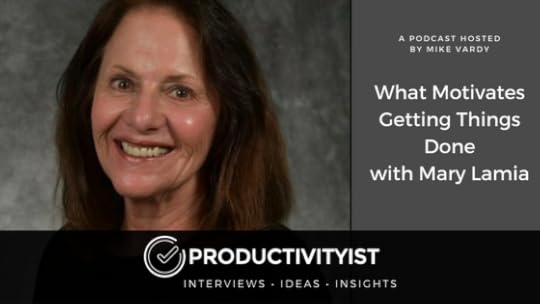
This episode of The Productivityist Podcast is sponsored by Health IQ, an insurance company that helps health conscious people like runners, cyclist, weightlifters and vegetarians get lower rates on their life insurance. Go to healthiq.com/vardy to support the show and see if you qualify.
Today’s guest is Dr. Mary Lamia – a clinical psychologist, psychoanalyst and the author of the new book What Motivates Getting Things Done.
We spoke about why it is important to have ways to create absolute deadlines, the role emotions have in personal productivity, the nature of distraction and more. Some of the topics we discuss include:
How specific deadlines combined with accountability can help
Task driven people vs. procrastinators
Why emotions are what really motivate us
A fear of failure is significantly present among those who are successful
Why shame anxiety is a powerful motivation too
Why distractions are not a bad thing
The importance of focusing your stress
Relevant Links:
Mary Lamia | Website
What Motivates Getting Things Done
Flow: The Psychology of Optimal Experience by Mihaly Csiksszentmihalyi | Amazon
How Procrastinators Get Things Done | Psychology Today
Mary Lamia @drlamia | Twitter
Thanks for listening. If you enjoyed the show don’t forget to subscribe so you don’t miss a single episode. Until next time remember to stop guessing…and start going!
If you’re interested in supporting the podcast and receiving exclusive content while doing so, you’ll want to check out the patrons-only version of The Productivityist Podcast on Patreon. Also, remember to leave The Productivityist Podcast a rating and review on iTunes, or on whatever platform you’re listening to. I read every single bit of feedback we receive. I want to make this show better and with your help I can do that. If you’d just like to support the podcast on its own, you can do so here.
The post What Motivates Getting Things Done with Mary Lamia appeared first on Productivityist.
March 5, 2018
Why You Shouldn’t Spend Time Journaling In The Morning (And What You Should Do Instead)
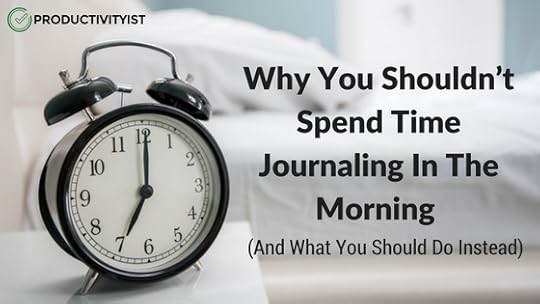
I’m a big fan of journaling. But I’m not a fan of taking time to write in your journal in the morning.
Before I dive too deep into this subject, I don’t want to get the idea of writing in the morning confused with writing in a journal in the morning.
The idea of “morning pages” as made popular by Julie Cameron in The Artist’s Way is a good one, but I don’t consider that to be journaling in its purest sense. That’s because when you work on these pages (or spend time “freewriting” as Mark Levy discusses in his book Accidental Genius), you’re not setting out to journal. Instead, you’re really emptying the mind. Sure, some of the things that might come out would fit into a journal entry but those would be incidental rather than intentional. In my mind, that doesn’t fulfill the promise of what journaling can offer you and your productivity.
In fact, when you write in your journal in the morning, you don’t have much to chronicle yet. If anything, you’re spending time writing out what you’re planning to do for the day. There may be other bits of writing that get into a morning journal entry but in my experience the majority of what is written are plans for the hours ahead. I don’t think that’s an effective use of that time.
So what should you do then?
First off, as I mentioned earlier, I am a big fan journaling. But you need to time it in a way that allows you to leverage the early part of the day for action as opposed to reflection.
That means when you start off your day – whether you’re a morning person or a night owl – you should invest your time, energy, intention, and attention to your plans for the day. (These are plans that you arranged ahead of time that allow you to be intentional. Otherwise, you are being reactive instead of proactive with your day.)
I journal at night, and part of that process involves mapping out my three “absolutes” for the next day. Those tasks are aligned with my Daily Themes as well. (If you’re using The NOW Year Weekly Worksheet Deskpad then you can simply write them down for each day you’ve planned, listing the primary absolute task at the top.)
Writing in my journal is part of my evening routine, so I begin my entries just as I’m closing out my day. At that point, I’m pretty much spent and I’m ready to fully reflect on the moments of the day that has just gone by. The act of journaling right before bed allows me to fall asleep faster and deeper because I’ve emptied all of the tanks – physical, mental, emotional, and spiritual.
Now you may not be a night owl like me so writing in a journal at the end of the day won’t work. No problem. Instead, pick one of these other times:
The End of the Workday
You can do this either before you leave the office or once you check that last email. The benefit of journaling at this time is that it could trigger a smoother transition from work life to home life.
You may even want to keep two journals: one for work and one for home. I know some people who do that and it allows them to keep their two lives as separate as possible. This helps them with perspective and balance… something we all could use a little more of these days.
After Dinner
Believe it or not, this is a great time to journal. Why? If you set it up right, you’ll have the time available to do an entry while you digest your food and have a trigger for your entry as well.
What do I mean by “trigger” for your entry? Well, you could begin each entry with what you had for dinner. This could be useful if you’re trying to eat better or just need something to get the journaling process going.
After dinner, you’ve still got the energy to write and time left to spend with family and friends. Plus you’ve attached the journaling habit to a consistent element of your day: dinner time. All of these reasons can lead to a consistent and beneficial journaling habit.
Try “Interstitial” Journaling
I received an email from my friend Ellis Nash that directed me to this tactic shared by Tony Stubblebine. As Tony puts in the piece, here’s the basic idea:
”…instead of tracking your work with a to-do list, track your work with a journal.”
I think you could also do this in tandem with a to do list. Actually, if you have our free daily progress planner, you could do this on the back of the sheet for each day.
While I don’t journal this way often, when I’m traveling I find that interstitial journaling helps. That’s because it allows me to chronicle the day when I’m on the go. The outcome is I wind up with a decent entry that I can simply wrap up before bed instead of devoting time to writing it entirely at bedtime.
What to Do Instead of Morning Journaling
It’s simple, really.
Move the plans for your day forward.
The simplest way to do this is, as I do, by indicating those plays through the previous day’s journal entry. You could also couple that with adding Daily Themes to your productivity framework (Daily Themes are a key element of TimeCrafting) and by doing that you give yourself “funnelled focus” for the day. You’ll have less in your way as you start to execute on the actions of the day.
Journaling aids in the planning through reflection. But you need space between the reflection and execution. That’s why journaling in the morning isn’t the best use of your time. Giving attention to your intentions for the day is.
Now if you’re not journaling already, you need to start today. It’s not that hard to do once you get started and the payoff is tremendous. In fact, you can check out The Small Wins 10 Day Journaling Challenge I’ve put together by entering your email below. It’s a great way to build a journaling habit that works for you.
The post Why You Shouldn’t Spend Time Journaling In The Morning (And What You Should Do Instead) appeared first on Productivityist.
February 28, 2018
The Free-Time Formula with Jeff Sanders
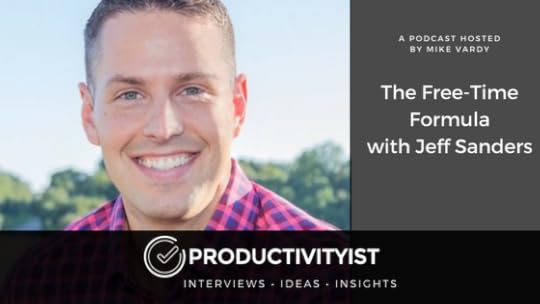
This episode of The Productivityist Podcast is sponsored by Health IQ, an insurance company that helps health conscious people like runners, cyclist, weightlifters and vegetarians get lower rates on their life insurance. Go to healthiq.com/vardy to support the show and see if you qualify.
Our guest this week is Jeff Sanders: a keynote speaker, founder of the Rocking Productivity Academy and the author of the new book The Free Time Formula. In this episode, we spoke about health-centered productivity, being intentional with your time, and much more. Here are a few more topics we covered:
Waking up with a plan and jumpstarting your day with intention
How the Free-Time Formula Works
How free-time is often already set with habits
The connection between health and productivity
Things Jeff has discovered in having health-first productivity approach
Focusing on quick wins over the short-term instead of the long-term
Finding a healthy rhythm with pausing
Jeff’s new productivity system
Relevant Links:
JeffSanders.com – Keynote Speaker and Author of the 5 AM Miracle
The Free-Time Formula Book by Jeff Sanders
The 5 AM Miracle Podcast
7 Essential Elements of Productivity | Jeff Sanders
Jeff Sanders @jeffsanderstv | Twitter
Thanks for listening. If you enjoyed the show don’t forget to subscribe so you don’t miss a single episode. Until next time remember to stop guessing…and start going!
If you’re interested in supporting the podcast and receiving exclusive content while doing so, you’ll want to check out the patrons-only version of The Productivityist Podcast on Patreon. Also, remember to leave The Productivityist Podcast a rating and review on iTunes, or on whatever platform you’re listening to. I read every single bit of feedback we receive. I want to make this show better and with your help I can do that. If you’d just like to support the podcast on its own, you can do so here.
The post The Free-Time Formula with Jeff Sanders appeared first on Productivityist.



